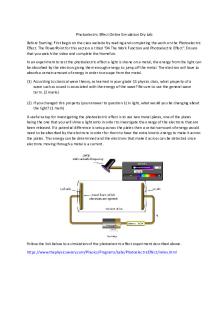Photoelectric Effect Online Simulation Dry Lab PDF

| Title | Photoelectric Effect Online Simulation Dry Lab |
|---|---|
| Author | M. T. |
| Course | Physics |
| Institution | High School - Canada |
| Pages | 2 |
| File Size | 87.1 KB |
| File Type | |
| Total Downloads | 81 |
| Total Views | 158 |
Summary
Notes...
Description
Photoelectric Effect Online Simulation Dry Lab Before Starting: First begin on the class website by reading and completing the work on the Photoelectric Effect. The PowerPoint for this section is titled “04 The Work Function and Photoelectric Effect”. Ensure that you watch the video and complete the Homefun. In an experiment to test the photoelectric effect a light is shone on a metal, the energy from the light can be absorbed by the electron giving them enough energy to jump off the metal. The electron will have to absorb a certain amount of energy in order to escape from the metal. (1) According to classical wave theory, as learned in your grade 11 physics class, what property of a wave such as sound is associated with the energy of the wave? Be sure to use the general wave term. (2 marks) (2) If you changed this property (your answer to question 1) in light, what would you be changing about the light? (1 mark) A useful setup for investigating the photoelectric effect is to use two metal plates, one of the plates being the one that you will shine a light onto in order to investigate the energy of the electrons that are been released. If a potential difference is setup across the plates then a certain amount of energy would need to be absorbed by the electrons in order for them to have the extra kinetic energy to make it across the plates. This energy can be determined and the electrons that make it across can be detected since electrons moving through a metal is a current.
Follow the link below to a simulation of the photoelectric effect experiment described above. https://www.thephysicsaviary.com/Physics/Programs/Labs/PhotoelectricEffect/index.html
The electrons that are released from the metal are illustrated as moving dots. If they do not have enough energy to reach the other plate they are pushed back. If they do have enough energy to reach the other plate then they are measured as “# of electrons detected” on the right. (3) Begin by increasing the brightness of the light in the simulation, while keeping the potential difference and the wavelength of the light constant. Describe the affect this has on the energy of the released electrons. (2 marks) (4) Now change the wavelength of the light in the simulation, while keeping the potential difference and the brightness of the light constant. Describe the affect this has on the energy of the released electrons. (3 marks) The link below is to another simulation of the photoelectric effect experiment, but with this simulation different metals can be chosen, and the kinetic energy (Ek) of the ejected electrons is shown on the right. Note: the ejected electrons are not illustrated/animated in this simulation. Feel free to experiment with the controls before performing the next task. https://www.viten.no/filarkiv/quantum-physics/photoelektriceffect_simulation/ (5) Using a metal of your choice plot a graph of electron kinetic energy (Ek) as your dependent variable and frequency of light as your independent variable, while keeping all other values constant. Be sure to label your graph with the type of metal used. (4 marks) (6) Describe the graph that you created in #5, what kind of relationship do you see? (2 marks) (7) Determine the slope of your graph, include units. What should the slope of this graph theoretically represent? (3 marks)...
Similar Free PDFs

Photoelectric effect notes
- 6 Pages

C3 Photoelectric effect
- 3 Pages

Chem dry lab d
- 3 Pages

Dry Lab 2b - Chem 1310 2B dry lab
- 13 Pages

Lab 3 Vector Lab Simulation
- 8 Pages

Endocrine simulation lab key
- 6 Pages

Enzyme Kinetics Lab Simulation
- 4 Pages
Popular Institutions
- Tinajero National High School - Annex
- Politeknik Caltex Riau
- Yokohama City University
- SGT University
- University of Al-Qadisiyah
- Divine Word College of Vigan
- Techniek College Rotterdam
- Universidade de Santiago
- Universiti Teknologi MARA Cawangan Johor Kampus Pasir Gudang
- Poltekkes Kemenkes Yogyakarta
- Baguio City National High School
- Colegio san marcos
- preparatoria uno
- Centro de Bachillerato Tecnológico Industrial y de Servicios No. 107
- Dalian Maritime University
- Quang Trung Secondary School
- Colegio Tecnológico en Informática
- Corporación Regional de Educación Superior
- Grupo CEDVA
- Dar Al Uloom University
- Centro de Estudios Preuniversitarios de la Universidad Nacional de Ingeniería
- 上智大学
- Aakash International School, Nuna Majara
- San Felipe Neri Catholic School
- Kang Chiao International School - New Taipei City
- Misamis Occidental National High School
- Institución Educativa Escuela Normal Juan Ladrilleros
- Kolehiyo ng Pantukan
- Batanes State College
- Instituto Continental
- Sekolah Menengah Kejuruan Kesehatan Kaltara (Tarakan)
- Colegio de La Inmaculada Concepcion - Cebu








